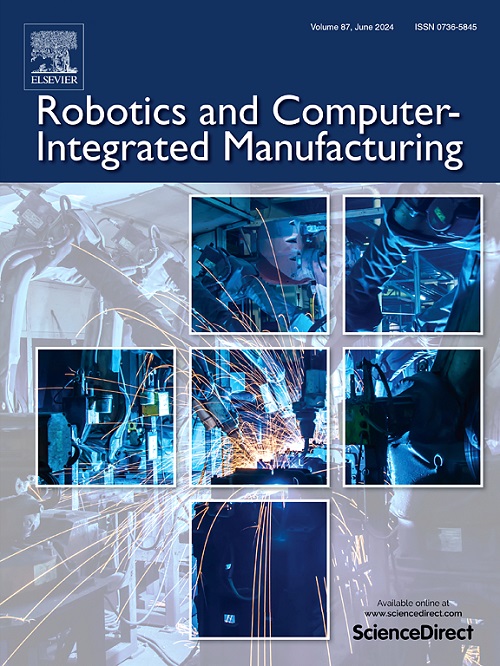密闭环境下焊接的宏微型协同机械手系统
IF 9.1
1区 计算机科学
Q1 COMPUTER SCIENCE, INTERDISCIPLINARY APPLICATIONS
引用次数: 0
摘要
焊接在广泛的行业中发挥着重要作用,包括航空、航天、汽车制造、核电站和化工厂,所有这些行业都包含关键的工业资产。然而,在这些环境中,有限的空间和复杂的结构严重限制了原位焊接任务的可及性和功能。为此,本文提出了一种多自由度的宏-微型协同机械手系统,以实现在受限空间的焊接作业。该协作系统由一个六自由度宏观机械臂和一个新型的二自由度超薄微型机械臂组成。宏观机械臂(即机械臂)提供大规模运动,以在受限环境中定位纤细的微型机械臂。细长的微型机械臂采用新颖的串联机构,然后调节和控制末端执行器(焊枪)的姿态,在宏观机械臂无法进入的空间执行焊接任务。考虑到微型机械手的新颖设计,运动学和雅可比模型已经被开发出来,以实现对协同焊接系统的亲密和精确控制。宏观和微型机械手之间的协作不仅发生在单个运动中,而且发生在每个系统上执行补偿运动以实现末端执行器(即焊枪)误差补偿的水平上。最后,对协作机械手系统进行了有限场景下的验证实验,验证了其功能和性能。本文章由计算机程序翻译,如有差异,请以英文原文为准。
Macro-mini collaborative manipulator system for welding in confined environments
Welding plays an important role in a wide range of industries, including aviation, aerospace, automobile manufacturing, and nuclear and chemical plants, all of which contain critical industrial assets. However, confined spaces and complex structures in these environments severely restrict the accessibility and functionality of in-situ welding tasks. Therefore, to enable welding operations in constrained spaces, a macro-mini collaborative manipulator system with multiple Degrees of Freedom (multi-DoF) is proposed in this paper. The collaborative system consists of a 6-DoF macro robotic arm and a novel 2-DoF slim mini manipulator. The macro manipulator (i.e., the robotic arm) provides large-scale movement to position the slim mini manipulator within confined environments. The slim mini manipulator, which features a novel serial mechanism, then adjusts and controls the pose of the end-effector (welding torch) to perform welding tasks in spaces that the macro manipulator cannot access. Given the novel design of the mini manipulator, kinematic and Jacobian modelling have been developed to enable intimate and accurate control of the collaborative welding system. The collaboration between the macro and mini manipulators occurs not only for individual movements but also at the level when compensatory movements are performed on each system to enable error compensation for the end-effector (i.e., welding torch). Finally, validation experiments of the collaborative manipulator system have been conducted in confined scenarios to verify its functionality and performance.
求助全文
通过发布文献求助,成功后即可免费获取论文全文。
去求助
来源期刊
CiteScore
24.10
自引率
13.50%
发文量
160
审稿时长
50 days
期刊介绍:
The journal, Robotics and Computer-Integrated Manufacturing, focuses on sharing research applications that contribute to the development of new or enhanced robotics, manufacturing technologies, and innovative manufacturing strategies that are relevant to industry. Papers that combine theory and experimental validation are preferred, while review papers on current robotics and manufacturing issues are also considered. However, papers on traditional machining processes, modeling and simulation, supply chain management, and resource optimization are generally not within the scope of the journal, as there are more appropriate journals for these topics. Similarly, papers that are overly theoretical or mathematical will be directed to other suitable journals. The journal welcomes original papers in areas such as industrial robotics, human-robot collaboration in manufacturing, cloud-based manufacturing, cyber-physical production systems, big data analytics in manufacturing, smart mechatronics, machine learning, adaptive and sustainable manufacturing, and other fields involving unique manufacturing technologies.

 求助内容:
求助内容: 应助结果提醒方式:
应助结果提醒方式:


